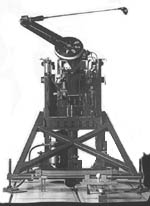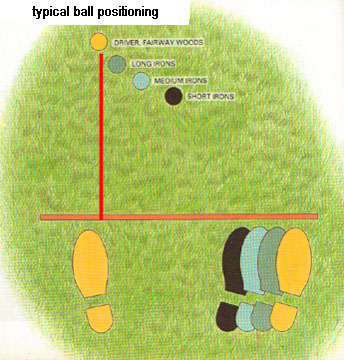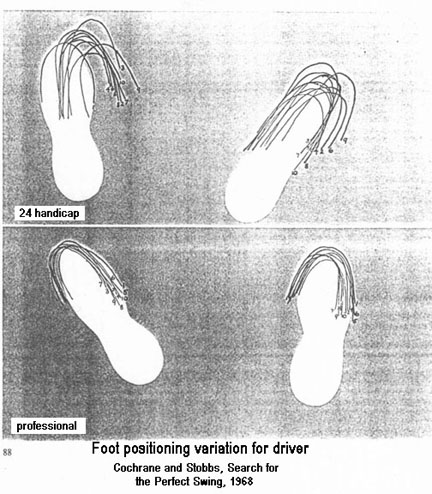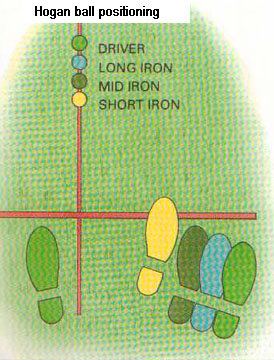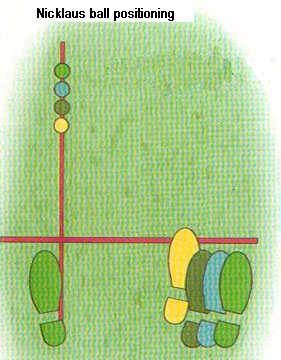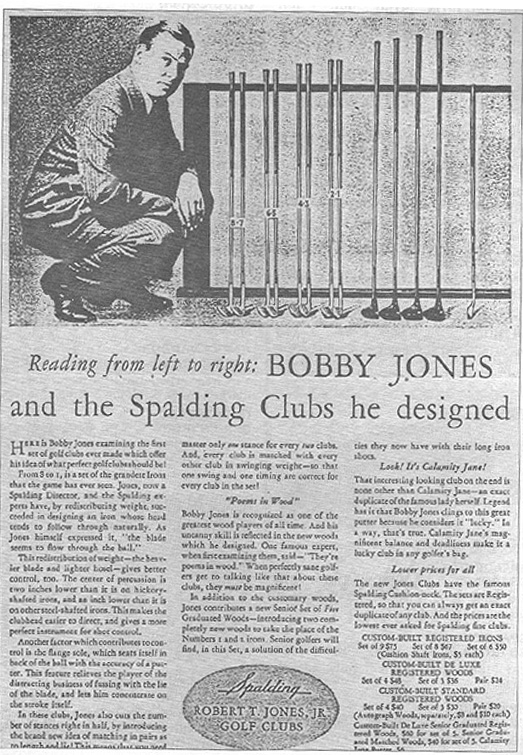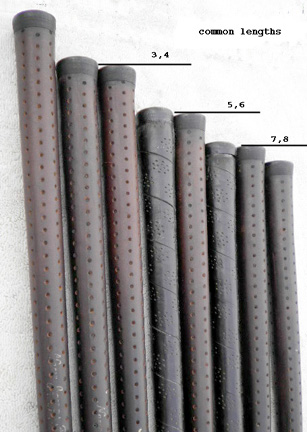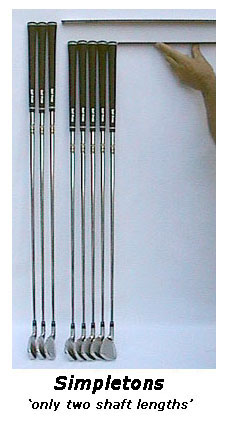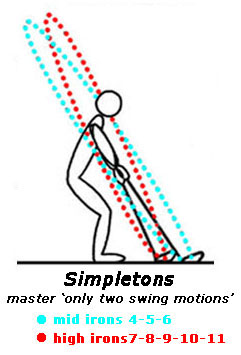|
Why average golfers
don’t improve Scores don’t improve much from year to
year for the average golfer, as least as measured by the National Golf
Foundation. In 2010 the stats were about the same as they’ve been over the
past few decades – 97 average score for male golfers – 114 for women – 100
combined average. Some think the reason is golfers don’t
play or practice enough. It is true that ‘conditioning’ of mind and body
leads to more reliable repetition. But, if one wants to improve on their
current state, they’ll need to make changes or else they are simply grooving
non-success. Taking lessons surely helps, if taken
from a knowledgeable teacher/observer, but that takes time and discipline not
just during the lesson but afterwards where one needs to re-engineer their
swing and mindset to the new, often uncomfortable techniques. ‘Change’ isn’t
easy. Golf technology provides yet another fix
for game improvement. We know from TV watching that pros are hitting the ball
longer than years past. And it might also be true that iron accuracy, chipping
and putting have improved, but that’s harder to verify, so we mostly take
vendor advertising claims on faith for these game segments. In fact, since the new drivers and
custom fit golf balls have aided the driving game without commensurate
average score reduction, logic says the other game elements may actually have
gotten worse. Serious golfers and
the robot What we do know is that a robot, like
the USGA’s Iron Byron, hitting shots in 2010 compared to 1970 is longer off
the tee and has lower shot dispersion with irons.
The robot is the most consistent ball
striker there is. Serious golfers like touring pros
emulate this robotic performance. But touring pros, with their remarkable
performances, need to sacrifice time for innumerable sessions on the practice
tee and often have sage advice to keep their swings tuned. And, since it is
their job, they willingly do it. Watching the top pros, or serious
amateurs for that matter, we note a short ‘bridge’ in their ball striking
capabilities to the robot. In fact, more than one commentator has quoted that
a given player is “hitting it like a machine”. But what about the average golfer? Does
a short ‘bridge’ exist between an average golfer’s performance and the best
players in the game? In fact, does “any” bridge exist for those arm flailing,
reverse pivoting, over-the-top, outside-in practitioners at all. We know the
answer. The average golfer is mired in a non-improvement rut. So the question to ask is whether what’s
good for the best, is good for the average golfer? We know the answer. There is no hope of
the average golfer ever achieving the serious-golfer proficiency without a
massive, time consuming effort. … but wait, as the great Billy Mays has
said, there might an in-between .. Perhaps if the average golfer tried some
new methods, techniques and apparatus suited more for HIS or HER poor game
instead of trying to emulate the pros, they COULD improve scores. Certainly
putting is addressable, and by now, most players use contemporary drivers
with the large 460cc head size to allow greater mishit margin than smaller
heads. Both of these appeal to common sense. But what of the iron game where
on about every hole, one, two or three irons might be hit. Although composing
a significant part of a player’s score in a game, it is the weakest segment
for the average player. Hybrid irons, introduced in the
mid-1980’s by Pinseeker, Spalding and Wilson, helped slightly since the
marketing message was that one could sweep the hybrid shot much like they
sweep a driver off a tee. True, except there is no tee in the fairway. For
those who play the ball as it lies instead of teeing it up on a clump through-the-green,
there isn’t much advantage in striking a 4 iron or equivalent hybrid. One thing we know for sure based on
average golfer scores for the past 3 or 4 decades, the existing technologies
haven’t done much, if anything, to improve average golfer performance. And
irons are the biggest culprit .. Maybe it’s time for the average player
to break with tradition .. Iron game
improvement for the average golfer
The problem Possibly the best ‘iron’ ball striker of
all time, Ben Hogan, once said “there are as many positions for the feet as
there are clubs in the bag “. This is illustrated below from the
Encyclopedia of Golf Techniques, Paul Foston, first edition 1989.
There are 3 complications to proper
setup with variable length clubs. First, the distance from the toeline to
the ball changes with each length of club. Think in terms of swinging two
sticks – one 3’ long and one 6’ long. Necessarily, to strike the ground with
the 3’ stick requires that ground striking point to be close to your toeline.
To strike the ground in a similar fashion with a 6’ stick, requires you stand
much farther back from the ground strike point. Second, for most golfers, the ball
position is moved slightly ‘back’ in the stance for each variable length
club. This is because the clubface must ‘square’ at point of impact for each
club on a properly executed swing and, as the variable length clubs get
shorter, it is easier to ‘square’ the impact moving the ball back. Otherwise,
the player must uncomfortably ‘reach’ for the ball. Third, the golfer needs to mentally and
physically combine the ‘distance away’ and ‘distance back’ for each club
length in his bag. For 8 iron club lengths that means one needs to have 16
separate setups and that’s for the basic ‘flat ground’ shot. This is further complicated by ‘how’ you
position your feet assuming you carry a ruler with you to physically measure
the precise ball positioning you need. Cochran & Stobbs in their “The
Search for the Perfect Swing”, 1968, and still the bible on the golf swing,
show how the best players consistently set up their stance compared to poor
players. Quoting from page 87 and as shown in the figure below “the main
difference in stance between good and bad players is that the good player
takes up his stance more consistently”.
As you can see, ball positioning changes
with each length of iron. In most cases these varying lengths also require a
change in the player’s stance. So if you have 8 or 9 variable length
irons, you have 8 or 9 setups and 8 or 9 swingplanes to imagine. Another point is that there are no real
rules on ball positioning setup. Note that some exceptional players like
Hogan and Nicklaus, as shown below, use alternative setups they found more
productive. It goes to show that even great ball strikers attempt to simplify
their stances by reducing the number of setup combinations. Others, like Seve
Ballesteros, have no set rules for positioning and instead let their comfort
level determine the setup. Now THAT takes real conditioning.
Unfortunately, hybrid irons don’t
successfully resolve this problem. Whether you are using a complete set of
Wilson TurfRiders or for lower irons only, today’s du jure solution, the
hybrids each have a different length and therefore require a different setup.
Multiple setups are a major complication
to the variable length iron game and intuitively a key reason that the iron
game continues to be such a mess for the average golfer. Even with perfectly matched multiple
length irons that each feel about the same when swinging them, a decision
still must be made on every iron shot as to setup and ball positioning. If
you setup 31” away when your best striking zone is at 30”, you don’t need
much science to realize that is a problem for shot execution. Even the robot
isn’t going to strike consistent shots 1” offcenter. And it’s not hard to relate to the
problem with your own personal experiment. Taking a friend with you to the
driving range, hit a dozen 5 irons recording the toeline-ball distance and
shot performance. You will soon discover that it is quite challenging to
consistently set the right ball address distance from shot to shot. You will
also note that when you are properly set, shot results are better. One last point regarding the basic setup
problem with multiple length irons. After you have painstakingly perfected
your setup for each iron, you also need to have the toeline aligned properly
to the target. Nuff said! It’s no wonder the average golfer can’t
improve their iron game with variable length irons! The Solutions Over many years there have been numerous
attempts to ease the shotmaking process for irons. Irons were originally
‘related’ for single irons and later ‘matched’ for sets. The relating,
matching or correlating (all terms historically used) criteria might be club
static weight, swing weight accounting for the physics measure ‘moment’,
shaft flexibility with variations, and so on. As early as the 1920’s,
designers and inventors had mentioned “getting clubs with consistent ‘feel’
from one another to help players of ‘moderate’ proficiency”. In the mid
1960’s even the engineering talent of putter guru Solheim Karsten had applied
to his correlated iron set, heads of the same length and a consistent shaft
axis to ball impact point. With lighter weight shafts and head
materials, club lengths have increased as has head size, all with the purpose
of making the iron game easier. But most of the technologies benefit the
serious golfer, not the average player struggling with fundamentals. On the other hand, the route taken by
design thinkers in the adjustable club field did have some bearing on ways to
simplify the game for the average player. While there is a gamut of materials on
adjustables dating to the early 1900’s, some, but not all, used the same
shaft for all the irons with the mentioned benefit of ‘same length’ for swing
consistency. In performing patent searches on ‘matching club design’, it is
remarkable how often patent credits and precedents are given to prior
adjustables. Doubling up lengths In the late 1930’s, Spalding developed a
set of Kro Flite irons under the direction of their star proponent, Bobby
Jones. These irons, shown below, mention the ‘matching’ of every two irons in
length “ to simplify the setup” for iron play. He says “.. by introducing the
brand new idea of matching in pairs as to length and lie, you need master
only one stance for every two clubs”. What qualifies this as important in the
iron length debacle is that Jones wasn’t only the greatest of his time and
maybe all time, but that he was an erudite intellectual and practicing
attorney less inclined to marketing puffery and more to real meaning. Watch
his instructional videos to understand why.
The dual lengths are illustrated more
closely below from a set for sale on the website www.clubsofdistinction.com.
Single length irons In the mid 1970’s a US patent was
granted for matched golf clubs of equal lengths. This became the basis for a
set of woods and irons from Tommy Armour Golf in 1989. The models had a five year
production run, a success then and, as we can testify being in the used club
business, a design with strong demand today (year 2011). The patent categorized golf clubs in 2
classes – woods and irons. In each class, their ‘matching’ criteria was
‘equal shaft length’, ‘equal lie angle’, ‘equal swing and total weight’. The
patent holder, Jack Nix, even mentioned Hogan’s statement in his Power Golf
book discussing ‘multiple stance positions as there are clubs in the bag’. Nix went further and said “the effect of
different shaft lengths and weights of clubs is a multitude of different sets
of body controls for the player to learn” and “ it follows that if each club
has a different shaft length , the plane of the arc swing will be unique for
each club. Consequently, the player must develop a different strict body
control discipline for each club. A matter of 14 accommodations for a
complete set of 14 clubs (sic) , not counting the putter” Later he says “ equal length and lie
angles reduce the complications facing the non-expert golfer in learning to
acquire the desired skill”. A final note is that he recognizes and
states that you cannot have a single ‘class’ due to the woods needing more of
a power swing than irons, which serve a different purpose. Triple length irons In the early 2000’s, Mirror Image
produced irons in 3 lengths. The story doesn’t change much in their
literature, that being that existing variable length irons are too complex
for an average golfer to manage. These irons were made for several years and
found success through a network of teaching pros that understood the
significance. Two length irons Simpletons Golf, begun in 2005,
established two lengths – one length for mid irons and one length for high
irons. The Simpletons proposition recognized two separate objectives for iron
play – one objective to simply advance the ball to proximity of the desired
target area – this is the role of the mid-irons. The second iron objective is
for shots where the expectation is to normally be ON TARGET – the high irons.
There are two swing planes to learn, one
for each outcome strategy. Most ‘average’ players think about hitting targets
with their 7 iron and up (the high iron class); most are content to be
‘around the target’ (the mid iron class).
In fact, for some players using higher
numbered fairway woods like 6’s and 7’s, the mid irons might be dispensed
with. Simpletons irons are sold directly for both men and women at
www.simpletonsgolf.com. Summary and
Conclusions There is no quick fix and the adage
about ‘the secret is knowing that there is no secret’, is never more true
than in the game of golf. Club designers have been wrestling with
the club matching problem for almost a hundred years. As irons evolved, the
higher lofted irons had bigger, heavier heads that required shorter lengths
to compensate for greater weight, especially when attempting to match or
correlate irons. Had today’s metal and materials
technology been available historically, smaller high loft heads on shafts of
equal length to lower lofted irons likely would have been the industry norm
instead of variable length irons. A number of years ago a management
concept named ‘re-engineering’ was conceived. The rationale made sense. If,
for example, you landed on the moon and wanted to set up a telephone network
for the colonists, would you string telephone poles from residences to
central offices or would you simply use wireless? The main reason we continue
with land based telephone lines today, has little to do with better reception
or costs. The fact is these exist solely because they are in place not
because they are better or even as good. Scores of average golfers of today
aren’t much improved over 40 years with many improvements in club design,
shafts, and golf balls. Golf irons historically have been the weakest game
segment for average players. While there are no miracles or secrets to golf improvement, perhaps it is time for the average golfer to shed the vicarious dream of the finest players and get down to some more basic, common sense simplifications, that have a reasonable, intuitive chance for payoff. Fewer lengths in irons is easier to understand, practice and play with than multiple lengths. It’s time to re-engineer the iron game. |
